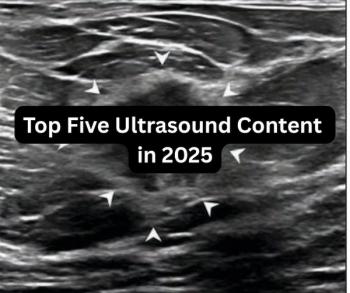
COVID-19 and Cancer: What a New Chest CT Study Reveals
Approximately 43 percent of patients with COVID-19 and preexisting cancer presented with atypical or indeterminate findings on chest computed tomography (CT) scans.
Emerging research suggests that a history of cancer may preclude imaging features radiologists would typically see on computed tomography (CT) scans in patients with COVID-19.
In a recently published study in
In addition to assessing patterns of involvement and CT scores, the study authors examined the impact of CT findings on mortality rates in this patient population.
While 42.8 percent of the cohort had typical CT features associated with COVID-19, the researchers found atypical findings in 21.8 percent of patients, indeterminate findings in 21.05 percent of patients and no findings in 14.29 percent of patients. The study authors found that indeterminate chest CT findings were nearly six times more common than typical features in patients with COVID-19 and preexisting breast cancer.
“ ... It may be hard to distinguish COVID-19 pneumonia from other non-COVID-19 diseases solely based on chest CT images. Radiologists should be aware that atypical, indeterminate, rare, or subtle CT patterns may be among the presenting radiological features of COVID-19 infection in patients with preexisting cancer,” wrote lead study author Faezeh Khorasanizadeh, M.D., who is affiliated with the Advanced Diagnostic and Interventional Radiology Research Center at the Tehran University of Medical Sciences in Iran, and colleagues.
Overall, Khorasanizadeh and colleagues found that patients with typical chest CT findings for COVID-19 had an approximately threefold higher mortality risk in comparison to patients with a normal chest CT scan. Patients with cancer and a CT severity score of 18 or higher had a 1.8-fold higher mortality risk in comparison to patients with normal CT scans, according to the researchers.
(Editor’s note: For related content, see “
For patients with a history of gastrointestinal cancer, chest CT findings of centrilobular nodule and architectural distortion were associated with 16.9-fold and 7.13-fold higher mortality risks, respectively, in comparison to patients without those chest CT findings, according to the study. Pleural effusion on chest CTs for patients with a history of hematologic cancer had a 5.34-fold higher mortality risk in comparison to those without that finding on chest CT.
Pointing out an example of typical ground-glass opacities one may see on chest CT in patients with viral or fungal broncho-pneumonia, Khorasanizadeh and colleagues emphasized appropriate diligence in considering differential diagnoses and careful review of prior imaging, clinical data, and reverse transcription polymerase chain reaction (RT-PCR) test results in high-risk patients with a history of cancer.
“In addition to the RT-PCR test, a clinical index of suspicion must be added to CT results to allow for earlier detection and proper treatment of COVID-19, which can be fatal in an oncologic setting,” maintained Khorasanizadeh and colleagues.
Newsletter
Stay at the forefront of radiology with the Diagnostic Imaging newsletter, delivering the latest news, clinical insights, and imaging advancements for today’s radiologists.




























